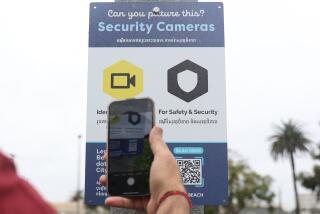D.C. is putting itself under surveillance
WASHINGTON — From a dimly lit room in a secure command center, 21 streaming video feeds from 4,775 surveillance cameras around the nation’s capital are projected across three screens and monitored at all hours. Every few seconds, footage from a different location pops up -- a busy road, a picnic bench, the entrance to the new baseball stadium.
Seven years after the Sept. 11 attacks, Mayor Adrian M. Fenty is trying to set up one of the most comprehensive centrally controlled visual surveillance systems in the world. In the nerve center, which opened last month, the city’s Homeland Security and Emergency Management Agency can monitor video from four city agencies -- covering streets, schools, housing projects, parks and roads -- for threats and other nefarious activities.
For those who have accepted the city’s fate as a prime terrorist target, this may be cause for relief. But to the many civil liberties groups headquartered in Washington, the move undermines privacy, encourages abuse and represents the first step toward a surveillance system like London’s, where a person’s every public move can be tracked on about 10,000 government-funded cameras that have been dubbed a “ring of steel.”
Soon, Fenty hopes, the system will include feeds from 5,625 cameras run by eight agencies, including the Metropolitan Police Department. But critics, including members of the District of Columbia Council, want to slow down.
“The program was announced without any detail or planning around who would have access, for what purpose, and what would happen with any video or digital archive,” said Councilman Phil Mendelson, who spearheaded a measure, approved June 3, to strictly limit how the cameras are used until the council can approve standards.
The video program’s future is somewhat blurry. Darrell L. Darnell, director of the agency that runs the new monitoring center, told the council: “All policies are still in draft and awaiting formal legal review.”
At least until that review is complete, the council has ordered the consolidated system to use the standards created in 2006 for the Police Department’s camera program. The standards require that footage be kept only 10 days unless it is believed relevant to a criminal investigation, and that the public be alerted as cameras are installed.
Besides helping Washington fight crime, the mayor’s office says, consolidation will cut the cost of monitoring the closed-circuit television feeds by a third. And officials say much of the expense in bringing the system together -- an estimated $5.1 million for fiscal year 2009 -- will be covered by federal grants. Homeland Security Secretary Michael Chertoff has praised cameras as a crucial anti-terrorism tool.
Still, some don’t think the cameras are justified.
James Jay Carafano, a counter-terrorism expert at the conservative Heritage Foundation, said he was concerned that the Homeland Security grants were encouraging cities to set up camera networks that they might not be able to maintain: “The problem is, in a couple of years, when the federal money runs out, you’re going to be stuck with that system.”
Others are concerned about broadening access to the public schools’ 3,500 cameras, though Washington officials say a central office can better deal with vandalism and school trespassing.
Nationally, no solid statistics are available on how many camera systems have been integrated. Civil libertarians have complained about city governments’ lack of transparency.
But Washington is not alone in expanding the use of cameras. Chicago and New York control thousands of cameras.
Los Angeles has considered consolidating camera systems, city officials say, but logistics and financing are obstacles. The city maintains camera networks at LAX and the port and around city buildings, and the Transportation Department has 32 traffic cameras. The Police Department has 80 cameras, monitored from about half a dozen police divisions, mostly in Hollywood, on Skid Row and at MacArthur Park.
Washington police say cameras make the streets safer. Last year, three homicides and an assault on a police officer were captured on video, a police study found.
And in areas within 250 feet of a camera, violent crime declined 19% last year, the study said.
Critics say cameras simply move crime onto side streets, out of video range.
“When you measure the effectiveness of these cameras against the harm they do to civil liberties, there just doesn’t seem to be a question for us,” said Johnny Barnes, executive director of the National Capital Area chapter of the American Civil Liberties Union.
Among residents, cameras are popular, said Councilwoman Muriel Bowser, who represents a relatively affluent northern area of Washington.
“There’s not a meeting or a community that I go into,” she told her colleagues, “that doesn’t tell us how cameras have positively impacted public safety in their neighborhoods.”
--
Times staff writer Andrew Blankstein in Los Angeles contributed to this report.
More to Read
Sign up for Essential California
The most important California stories and recommendations in your inbox every morning.
You may occasionally receive promotional content from the Los Angeles Times.










